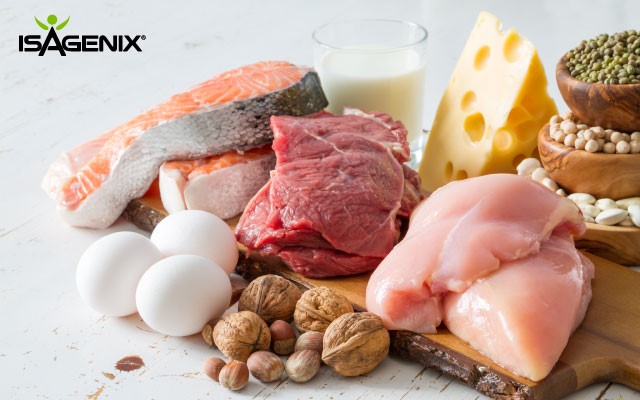Niacin, or vitamin B3, is one of the eight B-complex water-soluble vitamins. Niacin is a hard-working nutrient that supports many vital functions like metabolism and overall cardiovascular health (1).
Niacin is found naturally in two different forms, nicotinic acid and niacinamide, each with slightly different characteristics. Many foods such as meat, fish, milk, eggs, nuts, green vegetables, beans, enriched breads, and cereals are good sources of niacin.
Why is niacin important?
Like all B-complex vitamins, niacin works to help your body release energy from food. This is one reason why B vitamins, including niacin, are commonly used to support energy levels. Niacin is a major component of two critical coenzymes which are involved in many aspects of cellular metabolism (2).
Beyond its role in energy production niacin also acts as an antioxidant, plays a role in cell signaling, and is involved in the normal process of making and maintaining DNA (2). Without an adequate amount of niacin, you may experience symptoms such as memory loss, confusion, fatigue, headaches, and diarrhea. Outright niacin deficiency is uncommon and most people can meet their body’s basic requirement with a balanced diet.
However, consuming additional supplementation with niacin can be helpful for many people. Researchers have investigated the benefits of higher levels of niacin for supporting heart health and blood flow, among other functions (3-6)
What about flushing?
One side effect of some niacin supplements can be mild “flushing.” A niacin flush occurs as small blood vessels and capillaries relax, allowing blood to flow freely through your body. It’s often described as a feeling of warmth in combination with redness, itching or tingling of the face, neck, arms or upper chest. While this may be uncomfortable, it’s not harmful and will typically fade within a few minutes (2).
To help avoid this sensation, Isagenix uses niacinamide in most of its products because it’s known as the “nonflushing” form of niacin.
How much do I need?
Niacin is a water-soluble vitamin, so any amount that the body can’t use is easily excreted. This also means that you need to consume enough niacin daily since your body can’t store niacin. To maintain adequate niacin levels, the U.S. Institute of Medicine (IOM) recommends that people over the age of 14 consume 14 milligrams of niacin daily.
Adverse reactions to niacin are rare, but have been observed in doses of 3,000 milligrams in a day (7). As the table below illustrates, Isagenix Systems are designed to provide you with a safe and effective amount of niacin daily.
| Products Used on a Shake Day | Amount of Niacin | Products Used on a Cleanse Day | Amount of Niacin |
| Ionix® Supreme (1 serving) | 13 mg | Cleanse for Life® (4 Deep Cleanse Servings) | 8 mg |
| Natural Accelerator™ (2 capsules) | 24 mg | Ionix Supreme (1 serving) | 13 mg |
| IsaLean® Shake (2 Shakes) | 8 mg | Natural Accelerator (2 capsules) | 24 mg |
| Complete Essentials™ Daily Pack | 15 mg | Complete Essentials Daily Pack | 15 mg |
| Total | 60 mg | Total | 60 mg |
References:
- Robinson J et al. Meta-analysis of the relationship between non-high-density lipoprotein cholesterol reduction and coronary heart disease risk. Database of Abstracts of Reviews of Effects (DARE): Quality-assessed Reviews. 2009.
- Institute of Medicine (US) Standing Committee on the Scientific Evaluation of Dietary Reference Intakes and its Panel on Folate, Other B Vitamins, and Choline. Dietary Reference Intakes for Thiamin, Riboflavin, Niacin, Vitamin B6, Folate, Vitamin B12, Pantothenic Acid, Biotin, and Choline. Washington (DC): National Academies Press (US); 1998. Available from: https://www.ncbi.nlm.nih.gov/books/NBK114310/ doi: 10.17226/6015
- Lavigne PM, Karas RH. The current state of niacin in cardiovascular disease prevention: a systematic review and meta-regression. J Am Coll Cardiol. 2013 Jan 29;61(4):440-446. PMID: 23265337 ncbi.nlm.nih.gov/pubmed/23265337.
- Stone NJ, Robinson J, Lichtenstein AH, et al. 2013 ACC/AHA guideline on the treatment of blood cholesterol to reduce atherosclerotic cardiovascular risk in adults: a report of the American College of Cardiology/American Heart Association Task Force on Practice Guidelines. J Am Coll Cardiol. 2014 Jul 1;63(25 Pt B):2889-2934. PMID: 24239923 ncbi.nlm.nih.gov/pubmed/24239923.
- Velling DA, Dodick DW, Muir JJ. Sustained-release niacin for prevention of migraine headache. Mayo Clin Proc. 2003 Jun;78(6):770-1. PMID: 12934790 DOI: 10.4065/78.6.770
- Krumholtz HM. Niacin: Time to Believe Outcomes Over Surrogate Outcomes. Circulation: Cardiovascular Quality and Outcomes. 2016;9:343-344, originally published July 12, 2016. DOI: https://doi.org/10.1161/CIRCOUTCOMES.116.003094
- Hendler SS, Rorvik DR, eds. PDR for Nutritional Supplements. Montvale: Medical Economics Company, Inc; 2001.





